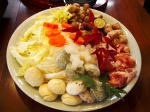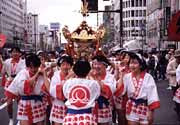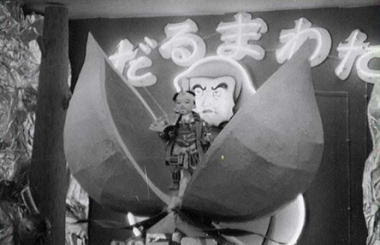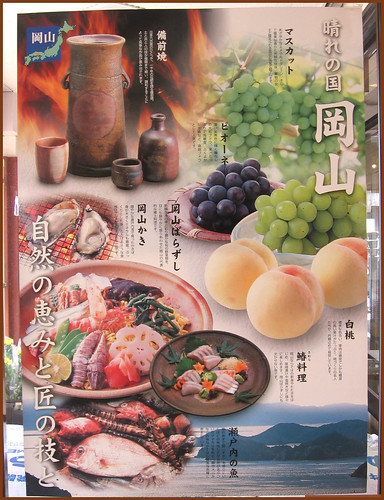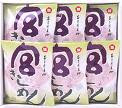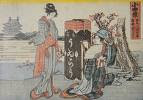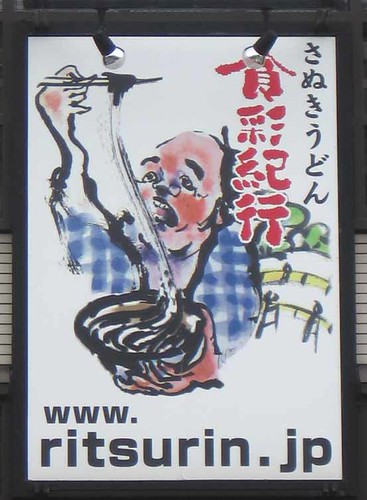::::::::::::::::::::::::::::::::::::::::::::::::::::::::::::::::::::::::::::::::::::::::::::::::::::
Mie Prefecture

Mie Prefecture (三重県, Mie-ken) is a prefecture of Japan which is part of the Kinki and Chūbu regions on Honshū island. The capital is the city of Tsu.
Evidence of human habitation in Mie can be dated to more than 10,000 years ago. During the Jōmon and Yayoi periods, agricultural communities began to form along the river and coastal areas of the region. Ise Shrine is said to have been established during the Yayoi period, and in the 7th century the Saikū Imperial Residence was built in what is now Meiwa Town to serve as both a residence and administrive centre for the Saiō, an Imperial Princess who served as High Priestess of Ise Shrine.
During the Edo period, the area now known as Mie Prefecture consisted of several feudal domains, each ruled by an appointed lord. Transport networks, including the Tokaido and Ise Roads, were built. Port towns such as Ohminato, Kuwana and Anōtsu, posting stations and castle towns flourished. Pilgrimages to Ise Shrine also became very popular.
Mie Prefecture forms the eastern part of the Kii Peninsula, and is bordered by Aichi, Gifu, Shiga, Kyoto, Nara, and Wakayama. It is considered to be a part of both the Chūbu and the Kinki regions due to its geographical proximity to Aichi Prefecture and its cultural influence from Kinki, such as the fact that Kansai dialect is spoken in Mie. Traditionally, though, the Iga region of Mie is considered to have always been a part of Kansai.
Mie Prefecture has traditionally been a link between east and west Japan, thanks largely to the Tokaido and Ise Pilgrimage Roads. Traditional handicrafts such as Iga Braid, Yokkaichi Banko Pottery, Suzuka Ink, Iga Pottery and Ise Katagami flourished. With 65% of the prefecture consisting of forests and with over 1,000 km of coastline, Mie has a long been associated with forestry and seafood industries. As well as this, Mie produces tea, beef, cultured pearls and fruit, mainly mandarin oranges.
© More in the WIKIPEDIA !
. Ise Grand Shrine 伊勢神宮 Schrein Ise Jingu
and related KIGO
Amaterasu Oomikami 天照大神(あまてらすおおみかみ・てんしょうだいじん)Amaterasu Omikami
Toyouke Oomikami 豊受大神 (とようけおおみかみ) Toyouke Omikami
The goddess of agriculture and industry in the Shinto religion. At the Gegu 下宮 in Ise.
She offers food to Amaterasu.
Kumano Kodō、Kumano Kodo, Kumano Kodoo 熊野古道
World Heritage Site. Ancient road in southern Mie once used by pilgrims.
Mikimoto Pearl Island
:::::::::::::::::::::::::::::::::::::::::::::::::::::::::::::::::::::::::::::::::::::::::::::::::::
Local Dishes from Mie 三重県の郷土料理
aimaze あいまぜ "mixed delight"
with dried radish, carrots, lotus roots, konnyaku, shiitake, taro roots and stems, fried in oil and soy sauce, with sweet vinegar as seasoning. Made for family festivals.
. . . CLICK here for Photos !
akafuku 赤福 a sweet made with mochi and sweet red bean paste
. . . CLICK here for Photos !
amago sushi あまご寿司 amagu (a sweet water fish) sushi
Oncorhynchus rhodurus. 甘子
It tasts quite crunchy and good with vinegar.
. . . CLICK here for Photos !
and other amago dishes アマゴ料理. It is a speciality of Tsu city and 美杉町.
aramemaki, arame-maki あらめ巻 fish wrapped in arame kelp
WASHOKU : arame 荒布 Eisenia bicyclis.
arare ochazuke あられお茶漬 arare senbei with green tea
You shovel a good portion in a large bowl, add some sugar and then poor green tea over it. They get funyafunja soft.
. . . CLICK here for Photos !
awabimeshi, awabi-meshi あわびめし rice with abalone
An expensive delicacy at Ise Shrine.
. . . CLICK here for Photos !
bekkoozushi, bekkoo sushi, bekko sushi べっこう寿司 'Tortoise-shell sushi'
sushi with "pickled" fish in soy sauce marinade, to make it look like the color of tortoiseshell Bernstein.
. . . CLICK here for Photos !
bora no heso ぼらのへそ "navel of the springer"
Bora ぼら【鯔/鰡】, striped black mullet; a springer
WASHOKU : bora, an auspicious fish
Actually, it is the stomach prepared to eat. Often barbequed.
ibukuro 胃袋 stomach
. . . CLICK here for Photos !
chazuke 茶漬け
after eating fried or boiled fish, tea (or simply hot water) is poored over the bones, head and other leftovers, which are carefully washed with the liquid. This is then slurped out of the plate. Or poored over rice and eaten.
This is very healthy, called "isha shirazu 医者知らず" or "isha koroshi 医者殺し", no need for a doctor.

dengara でんがら dumplings with anko wrapped in a hoo-leaf
ほう葉だんご
from Iinan town 飯高
:::::::::::::::::::::::::::::::::::::::::::::::::::::::::::::::::::::::::::::::::::::::::::::::::::::
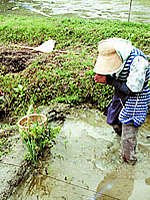 fukidawara 蕗俵(ふきだわら)
fukidawara 蕗俵(ふきだわら)"butterbur barrels"
rice with beans, wrapped in fuki leaves
They were prepared during the rice field planting season and put as offerings for the deities on the side of the fields.
Here you see a woman praying for a bountiful harvest.
hijiki nimono ひじき煮物 boiled hijiki seaweed
from 伊勢志摩 Ise Shima region. Ise hijiki 伊勢ひじき
Shima is one of the foremost producers of hijiki in Japan.
Hizikia fusiformis. Braune Meeresalge
:::::::::::::::::::::::::::::::::::::::::::::::::::::::::::::::::::::::::::::::::::::::::::::::::::::
Ise ebi 伊勢エビ料理 lobster from Ise
from 伊勢志摩 Shima
They are prepared in many ways.
. . . CLICK here for Photos !
Ise takuan 伊勢たくあん pickles radish from Ise
rather thick and round, the skin is thick. Made since the end of the Meiji period.
Ise udon 伊勢うどん ... see menrui, udon.
They are rather thick and soft. The soup is made with tamari soy sauce
served at (伊勢神宮)Shrine Ise Jingu to the pilgrims.
Itoin Senbei, ito-in senbei いといんせんべい. 絲印煎餅
Senbei with a "stamp like a thread"
Made by Hadaya Shop 播田屋, who owns three old metal stamps.
They are specially soft and made with a stamp (in) from olden times. The imperial family likes to eat them on their round to Ise shrine.
There are only 7 senbei in one pack, since the time when Meiji tennoo could only eat 7 out of a pack with 10.
. . . CLICK here for Photos !
iwashizushi, iwashi sushi イワシ寿司 sushi from herrings
from the Satonakakokoro area 里中心
jibu じふ sukiyaki-type fish
魚のすき焼き風, jibunabe じふ鍋
from the Northern parts of the prefecture
:::::::::::::::::::::::::::::::::::::::::::::::::::::::::::::::::::::::::::::::::::::::::::::::::::::
kaizu no himono かいずの干物 dried small sea bream
kaizu are the small black sea breams (kurodai 黒鯛 ). They are cut open on the back, marinated in soy sauce and dried in the sun. From Ocotber to November in the Toba area. 鳥羽地方
. . . CLICK here for Photos !
kakimeshi カキ飯 rice with oysters
The oysters are boiled together with the rice in the same pot.
katsuo chazuke かつお茶漬け bonito on rice with tea
The fish is marinaged in soy sauce. Served with ginger and nori.
. . . CLICK here for Photos !
kijinabe きじ鍋 hodgepodge with pheasant meat
kinko きんこ dried sweet potatoes
a snack for children and ama female divers
. . . CLICK here for Photos !
koonago no kama-age コウナゴの釜揚げ boiled small sand lance
koonago is the local name for ikanago イカナゴ いかなご【玉筋魚】sand lance, sand eel lance
Ammodytes personatus
. . . CLICK here for Photos !
Kuwana no hamaguri ryoori 桑名の蛤料理 clam dishes from Kuwana town
At the estuaries of the rivers Kisogawa, Naragawa and Machiyagawa 町屋川.
. . . CLICK here for Photos !
kyuuri no hiyajiru キュウリの冷や汁 cold cucumber soup
It is put on hot mugimeshi rice. A mix between chazuke and salad. The soup has a miso taste.
:::::::::::::::::::::::::::::::::::::::::::::::::::::::::::::::::::::::::::::::::::::::::::::::::::::
manboo ryoori マンボウ料理 dishes from moonfish (headfish)
Mola mola. Mondfish. まんぼう 【翻車魚】 満方 ocean sunfish
This fish is caught in Eastern Kishu. Eaten as sashimi, in vinegar, as sukiyaki. Even the intestines (kowata コワタ(腸)are dried and eaten.
. . . CLICK here for Photos !
Manbo (Mambo) is also eaten in Miyagi prefecture.
:::::::::::::::::::::::::::::::::::::::::::::::::::::::::::::::::::::::::::::::::::::::::::::::::::::
Manjuu kaidoo 饅頭街道 Manju Road
Mie is famous for more than 15 different kinds of manjuu dumplings.
They were prepared by the various tea shops in front of the Ise Shrine and people would buy them as presents nowadays.
. . . CLICK here for Photos : manju from Mie !
akafukumochi 赤福餅
The Manju Road leads from Ise shrine.
There are other Manju Roads in Japan too, for example one in Nagasaki.
:::::::::::::::::::::::::::::::::::::::::::::::::::::::::::::::::::::::::::::::::::::::::::::::::::::
Matsuzaka beef
moroheiya udon モロヘイヤうどん udon noodles with moroheya
The moroheya powder is mixed with the wheat flour for making green noodles.
Corchorus Olitorius. Jew's marrow.
. . . CLICK here for Photos !
:::::::::::::::::::::::::::::::::::::::::::::::::::::::::::::::::::::::::::::::::::::::::::::::::::::
nabana no ohitashi なばなのおひたし boiled rapeseed buds and young leaves
Very old dish of the Ise region.
nabemochi なべ餅 "hodgepodge mochi"
Mochi are made with anko and yomogi, rolled in kinako soy flour.
from 大紀町 Taiki Town
This was only prepared on auspicious situtations and the mochi were given to the neighbours and friends.
namako no su no mono なまこの酢の物 sea cucumber with vinegar
sea cucumber is also eaten in other dishes, often for New Year.
nameroo なめろう chopped raw fish with sake and miso paste
In Mie, apart from fish, sazae turban shell is used.
さざえのなめろうsazae no nameroo
also eaten in Chiba.
niken chaya mochi 二軒茶屋餅(にけんちゃやもち)mochi from Niken Chaya shop, Kakuya 角屋
nubarizushi, nubari sushi めばり寿司 sushi with takana leafy vegetable
a form of takanazushi. 高菜 takana leaves are marinated in nibaizu or sanbaizu vinegar and then the warm leaf wrapped around sushi rice.
takana, Brassica juncea var. integrifolia. Wirsingart
. . . CLICK here for Photos !
. Takana 高菜 mustard greens .
:::::::::::::::::::::::::::::::::::::::::::::::::::::::::::::::::::::::::::::::::::::::::::::::::::::
Oga no aburi 梶賀のあぶり smoked small fish from Oga town
from 尾鷲市梶賀浦
Prepared in May and June.
. . . CLICK here for Photos !
oojiki jiru 大敷き汁 "soup after a good catch"
miso-based soup with the fresh catch. Saba, ika, katsuo, aji, sometimes even Ise lobsters.
. o-nyudo senbei おにゅうどうせんべい rice crackers
 osasuri おさすり dumplings(ebitsu えびつ)
osasuri おさすり dumplings(ebitsu えびつ)from Eastern Kishuu 御浜町
a kind of kashiwamochi
Prepared one month later than the normal Boy's festival, on June 5, and for the girls.
Sakatejima no uni 坂手島の雲丹 sea urchin from Sakatejima
Best for sushi.
. . . CLICK here for Photos !
same no tare サメのたれ Samenotare, dried white shark meat
In Ise, shark is served with two different flavors, salt or sweet sake (mirin).
It is often served as a side dish. Ssamenotare goes well with drinks or served on top of rice.
. . . CLICK here for Photos !
sanmazushi 秋刀魚寿司 (さんまずし) sanma sushi
sushi from pacific saury. Instead of wasabi, a bit of Japanese karashi mustard is used before the fish is pressed on the rice. サンマ寿司
. . . CLICK here for Photos !
sazae no tsuboyaki さざえの壺焼き sazae turban shell grilled in the shell
Batillus cornutus
sekihan mochi 赤飯もち mochi made from mashed red rice
shigure hamaguri 時雨はまぐり, 時雨蛤 sweet simmered clamshells
English Reference : sweet cooked clams

sooheinabe, soohei nabe 僧兵鍋 hodgepodge for the monk-soldiers
Near Yunoyama onsen hot spring is the temple of the Tendai sect, 三岳寺, where the monks function as soldiers too and need some stamina. There are even pork bones used for broth, then radish, carrots, Konnyaku, lotus roots, taro and yam, bamboo shoots and even wild boar meat are used.
tekonezushi, tekone sushi てこねずし . 手こねずし fish zushi mixed with the hands
Tsu gyooza 津餃子 gyoza from Tsu town
They are very large, about 5 time the contents of a normal dumpling. They are fried and eaten without sauce.
CLICK here for PHOTOS !
unagi ryoori うなぎ料理 eel dishes
from Tsu town. In Tsu most of the eel in all of Japan is eaten.
::::::::::::::::::::::::::::::::::::::::::::::::::::::::::::::::::::::::::::::::::::::::::::::::::::
watarikaki 渡利牡蠣(わたりかき)Oysters from the Kihoku 紀北町 region. It is almost a sweet water lake with an underlying current of sea water.
They are also called
Kooboogaki 弘法ガキ
CLICK here for PHOTOS !
Commercial oysters are produced since the Showa period.They have a juicy taste. This is as a result of its production in the nutrient-rich water of the local Funatsu River and Sea of Kumano. They are lowered to salt water after a typhoon or great rain, when the river brings lots of nutrition for the oysters. Later they are put in a higher position of the fresh water of lake Shiraishiko 白石湖. So the oyster farmers are quite budsy checking the saltiness of the lake water.
Taken out of the water, they keep fresh for about 5 days if they are not opened.
The oysters are eaten fried or raw, but also in soup (kakijiru 牡蠣汁) or on sushi rice with a bit of hot mustard (kakizushi 牡蠣寿司 ).
*****************************
Things found on the way
*****************************
HAIKU and SENRYU
*****************************
Related words
***** WASHOKU : Regional Japanese Dishes
***** . Folk Toys from Mie .
:::::::::::::::::::::::::::::::::::::::::::::::::::::::::::::::::::::::::::::::::::::::::::::::::::::::::::::::::::::::::::
[ . BACK to DARUMA MUSEUM TOP . ]
[ . BACK to WORLDKIGO . TOP . ]
:::::::::::::::::::::::::::::::::::::::::::::::::::::::::::::::::::::::::::::::::::::::::::::::::::::::::::::::::::::::::::


